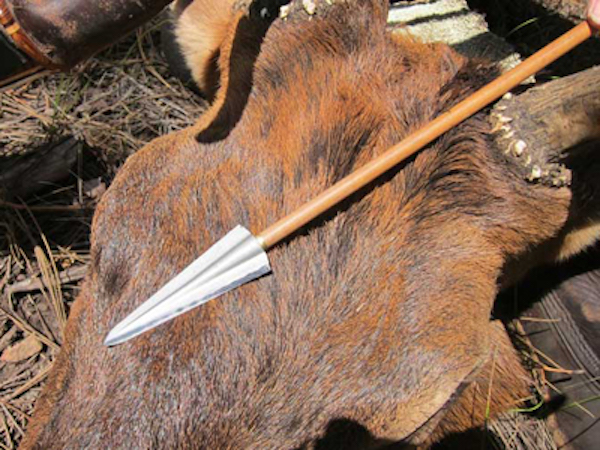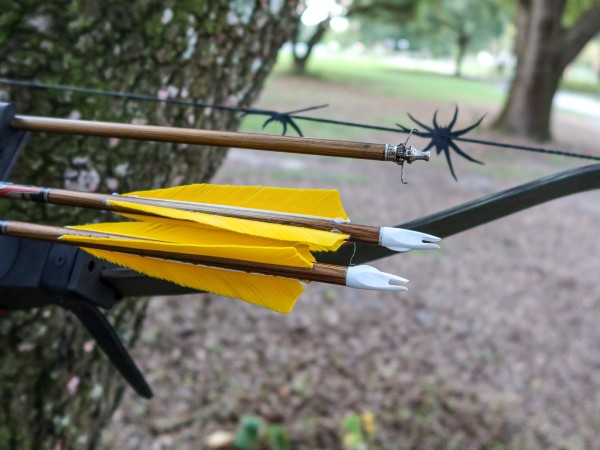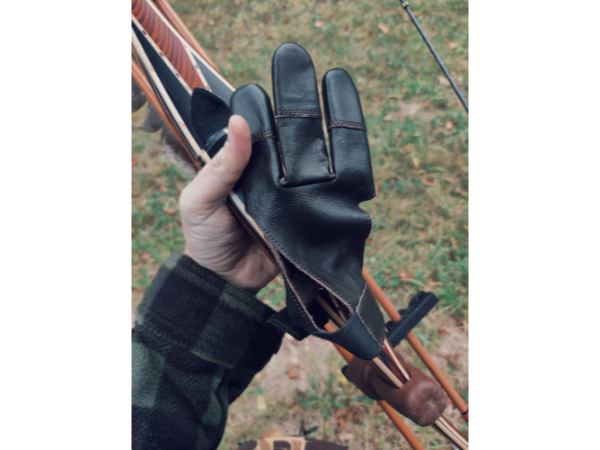Many folks are still confused about single bevel broadheads. A single bevel broadhead is sharpened on only one side of each edge; the opposite edge remains flat. If the bevel (sloped edge) is on the left looking from the base of the broadhead to its point, it’s a left bevel; if the bevel is on the right, it’s a right bevel.
 I’m often asked which bevel should be shot with helical fletching. The simple answer is that it depends on whether your arrows have right or left wing feathers (fletching). The image here shows how to tell if your arrows have right or left wing feathers. Left wing feathers make the arrow rotate in a counterclockwise direction while right wing feathers will rotate the shaft in the opposite direction.
I’m often asked which bevel should be shot with helical fletching. The simple answer is that it depends on whether your arrows have right or left wing feathers (fletching). The image here shows how to tell if your arrows have right or left wing feathers. Left wing feathers make the arrow rotate in a counterclockwise direction while right wing feathers will rotate the shaft in the opposite direction.
A single bevel broadhead will begin to “twist” or rotate upon impact due to the reaction of the single bevel against meat or bone. The theory is that the rotation of the single bevel broadhead should match the shaft’s rotation so penetration is not impeded upon impact.
If your arrows are fletched with right wing feathers, you should use right beveled broadheads; likewise, use left beveled broadheads if you use left wing feathers. (With straight fletching, it really doesn’t matter which bevel you use as there is very little rotation of the shaft.) Failure to match a single bevel with the fletching will result in wasting an arrow’s energy. For example, a left single bevel broadhead trying to rotate counterclockwise upon impact would have to overcome the momentum of right wing feathers rotating the shaft the opposite way.
Buy your broadheads accordingly. If you are ordering directly from the manufacturer, ask them to grind the bevel you want.
Too, remember that the clamps for fletching arrows must also match your feathers ~ either right, left or straight.







One slight note on my experience. I right wing feathers in a straight clamp. I get plenty of rotation, as the natural shape and texture of the feather will turn the shaft. In theory, I fletch straight to reduce the drag and maybe the noise. I don’t chronograph and my ears aren’t the best so I don’t have any science behind that, just things I’ve read. Best, dwc
An easy way I use to remember which is right or left wing is that if you look from the rear (like the diagram) of the left wing feather the feather and the catch lip form an L for left. Makes it simpler for me
I am going to buy some single bevel broad heads and shoot them.
I know that broadhead style and choice can be argued for whatever works for you, but is there some actual science or factual evidence behind the recent popularity of single bevel heads? Other popular styles have come and gone as fads but something like the Zwickey or old Bear heads hang in there and still work. Has it been quantified that a single bevel actually works better somehow or is it all anecdotal and marketing?
Hi Len. Dr. Ed Ashby has done extensive studies on broadhead penetration, and all of the articles in his Lethality Study are posted on our site. You can find the link in the footer of every page. There is one article in particular that might explain things, Why Single Bevel Broadheads? It certainly isn’t the only way to do, and as you stated strong two blade broadheads also work well. It all comes down to personal choice.
To much thinking
Can’t help feeling that something doesn’t quite add up so I tried this by pushing a loose broadhead through a block of Styrofoam. The broadhead rotates towards the side without the bevel. If the bevel is on the left it rotates to the right. A head with what is described above as a left bevel would turn to the right. Shouldn’t that match up with right wing feathers.
Kevin Lance, you are CORRECT! I’m thinking about sending the following info out to ALL the folks saying “right” bevel should be matched to “right helical” fletchings . I’m using single bevel broadheads for the first time this fall and I’m also a science teacher. As I was sharpening my new blades and reflecting ALL my arrows, I thought I could use this to demonstrate Bernoulli’s principle that I teach in my science classroom (it what causes wings to lift birds and airplanes…). I took photos and was editing them so they could be used as a quiz question with arrows and letters for multiple choice. But when I was “solving” the problem I realized that a right bevel would rotate to the left… SOOOO, I went to my shop and started shooting close range arrows; bare shaft with broadhead, field point with right helical fletching, bare shaft with fieldpoint, etc. based on an article I read online. The problem is that this process is not really definitive and I will spare you the lengthy science explanation as to why…. But the simple test is wind on the arrow while it can spin freely. And I RECORED THE RESULTS… A right helically fletched arrow spins to the right (as Bernoulli’s principle predicts). But…. a “right bevel” broadhead spins to the LEFT! (As Bernoulli’s principle ALSO predicts). The greater the surface area, the greater the velocity, which reduces pressure causing ONE SIDE to exert a greater force on the other. Look at the cross section of a wing. The wing moves in the direction of the greatest surface area. In the case of a right bevel broadhead, if you look down the shaft from the nock, the LEFT side of the broadhead has the greatet amount of surface area and therefore the arrow spins to the left. The industry is completely promoting the WRONG thing here and I have video proof. Maybe I’ll post it on YouTube or something.
But it’s cost me time and money because I’ll need to refletch all of my arrows again. Of course, shooting a right bevel broadhead with right helical fletching will MINIMIZE spin with only a slight cost in velocity. So maybe it does produce better arrow flight since too much spin is a bad thing. Basically, my current setup should cause an arrow to rotate very little during flight and that might not be such a bad thing…. I’ll test it at 50–60 yards before I refletch all of my shafts…